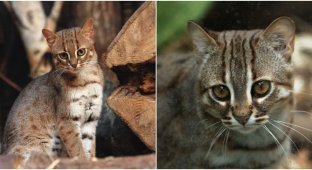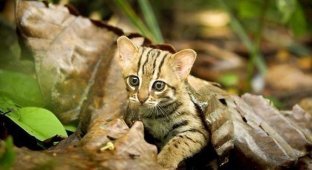Small-caliber predators: 10 smallest wild cats in the world (11 photos + 4 videos)
Large representatives of the cat family like lions and tigers always attract a lot of attention with their size and menacing appearance. However, most of their related species are small cats that tend to stay in the shade. To correct this omission, Around the World compiled the top 10 smallest wild cats on the planet. 
Rusty or spotted ginger cat
The rusty cat, which is found in India and Sri Lanka, claims the title of the smallest cat in the world. 
Rusty cat (Prionailurus rubiginosus)
On average, adult individuals weigh about 1.2 kilograms, and in length, including the tail, reach 60 centimeters. The grayish fur of rusty cats is decorated with red stripes and spots, which is how these animals got their name. This color provides small cats with good camouflage in tropical forests, where they hunt small vertebrates and some insects.
Black-footed cat
The most “compact” African feline is the black-footed cat, which local tribes call the “ant tiger,” which lives in the arid expanses of southern Africa. 
Black-footed cat (Felis nigripes)
The average weight of male black-footed cats is about 2 kilograms and their length is 60 centimeters, of which almost a third is the tail. These cats, with excellent eyesight and hearing, usually hunt at night and spend daytime hours in burrows, hiding from the heat and larger predators. By the way, contrary to the name, only the soles of the animals’ paws are black or dark brown.
Southern tiger cat
Until 2013, these cats, found in the jungles of Brazil, Argentina and Paraguay, were considered a subspecies of Oncilla, but were eventually identified as a separate species in the genus of South American cats. 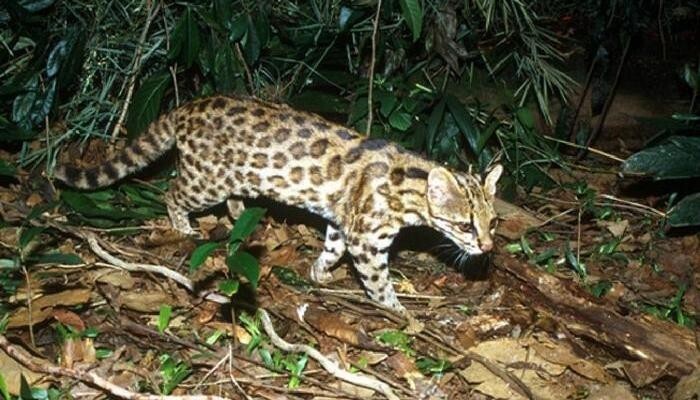
Southern tiger cat (Leopardus guttulus)
Representatives of this species have a spotted leopard coloration and hunt lizards, birds and small mammals, competing with larger ocelots. The average weight of an adult southern tiger cat is just over 2 kilograms, and the length including tail is about 80 centimeters. Scientists estimate that the species is endangered due to tropical deforestation.
Sumatran cat
Secretive Sumatran cats occasionally catch the eye of naturalists in the tropical forests of Sumatra. They are also found in Borneo (Kalimantan) and the Malay Peninsula.
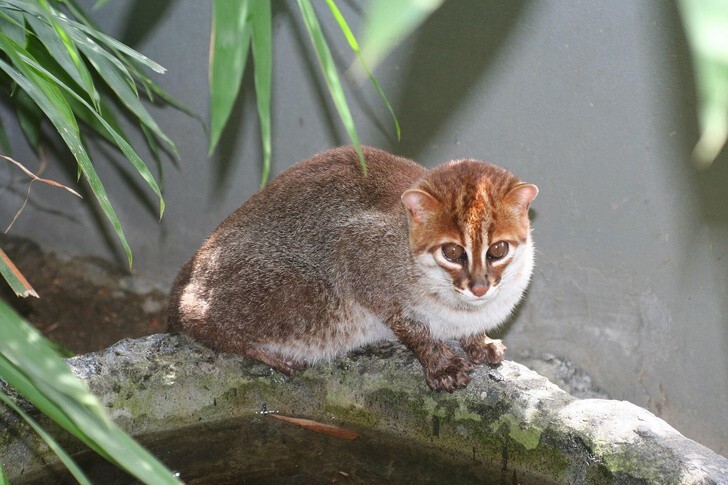
Sumatran cat (Prionailurus planiceps)
The average weight of an adult Sumatran cat is about 2 kilograms, and they reach a length of approximately 60 centimeters. The relatively short tail accounts for about a quarter of the animal's length. Unlike many of their relatives, Sumatran cats prefer to settle near fresh water bodies. The basis of their diet is fish; they also hunt frogs and crustaceans. Due to the rapid destruction of their natural habitat, Sumatran cats are included in the list of species on the verge of extinction.
Dune cat
Adapted to living in harsh conditions, sand cats are found in the desert regions of North Africa, the Arabian Peninsula and Central Asia.
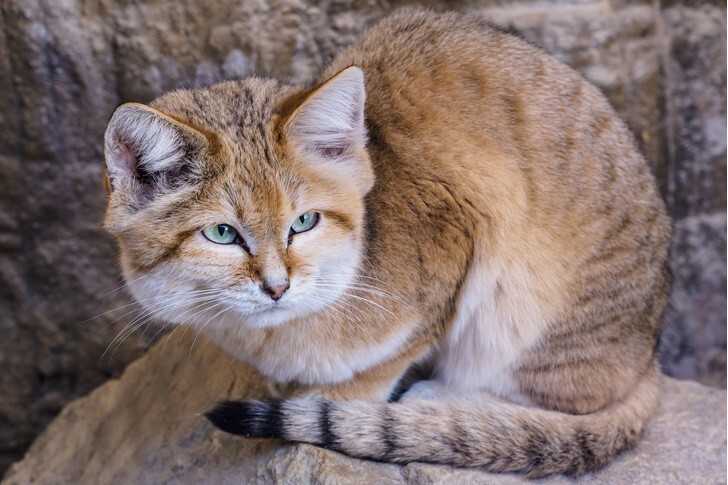
Dune cat (Felis margarita)
The sand cat's thick fluffy fur perfectly protects it from the cold of the night, and it spends the hot daytime hours in a hole or other shelter. The sand cat successfully hunts rodents, birds and snakes, eating which it meets its needs for both food and valuable moisture. The average weight of representatives of this feline species is 2.3 kilograms, and the length is about 70 centimeters, of which over a third is the tail.
Kalimantan cat
Found on the island of Borneo, the Kalimantan cat is one of the rarest cats in the world and, alas, is on the verge of extinction.
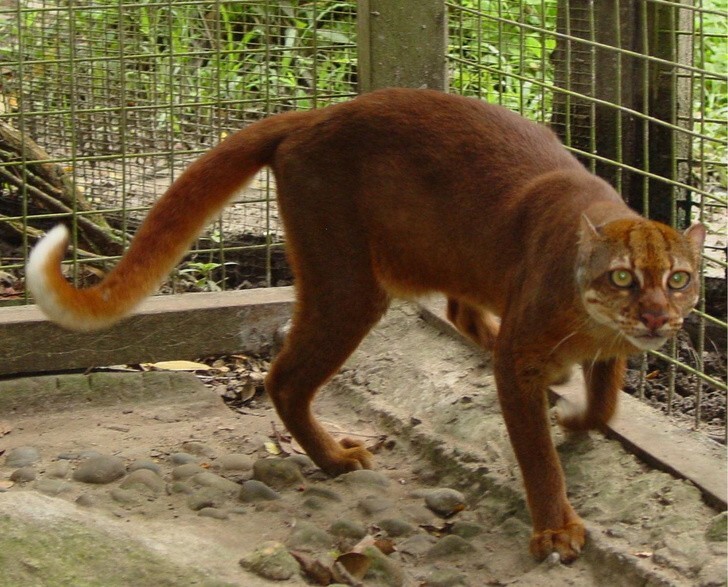
Kalimantan cat (Pardofelis badia)
This species was described in the 19th century from the skull and skin, butScientists managed to see the Kalimantan cat alive only at the end of the 20th century. Since then, about two dozen individuals have caught the eye of people. Because of this circumstance, it is difficult to determine the average size of Kalimantan cats - judging by the available data, they can reach a length of 80-110 centimeters including the tail and weigh 3-4 kilograms. Zoologists know practically nothing about the lifestyle of the graceful Kalimantan cats.
Long-tailed cat
In the humid forests of Central and South America there is a secretive long-tailed cat, or margay, which is a close relative of the ocelot.

Long-tailed cat (Leopardus wiedii)
It fully justifies its name: the average length of the head and body of an adult is a little more than 60 centimeters, and the tail adds about 40 centimeters to it. Margay weighs approximately 3.3 kilograms. The long tail helps the animal balance when climbing trees and during spectacular jumps between branches. Unlike most cats, the margay, like a squirrel, can climb down a trunk upside down and stay on the branches using only its powerful hind legs.
Margay the Cat (an extremely skilled tree climber)
Manul
Known for its gloomy appearance and unsociability, the Pallas cat, or Pallas cat, lives in the mountains and steppes in Armenia, Mongolia, Kazakhstan, Iran, China and a number of other countries. The image of a manul adorns the logo of the Moscow Zoo.
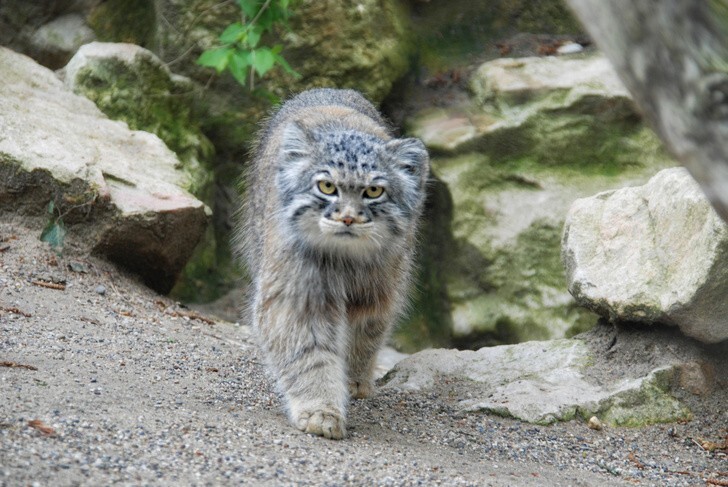
Pallas's cat (Otocolobus manul)
In size, the Pallas's cat is comparable to a large domestic cat, but differs from it in its exceptionally fluffy fur, which warms the Pallas's cat in the cold of winter, and in its more massive build. The average length of the Pallas's cat including the tail is approximately 80 centimeters, and the weight is about 3.5 kilograms. The Pallas cat runs relatively slowly and prefers to hide from enemies in holes and rocky crevices. If a fight with a larger pursuer is inevitable, then the manul turns over on its back and desperately defends itself with sharp claws and teeth. Despite its popularity, this species remains poorly studied, and breeding manuls in zoos is fraught with considerable difficulties.
Iriomotean cat
Residents of the small Japanese island of Iriomote have long known about the cat living in the forests on the slopes of low local mountains, but scientists managed to discover it only in the mid-1960s. As a result, the rare animal was described as an endemic subspecies of the Bengal cat.

Iriomothean cat (Prionailurus bengalensis iriomotensis)
Over the course of several decades, zoologists have managed to collect some information about Iriomotean cats. Judging by the accumulated data, we can say that the average weight of an adult is approximately 3.5-4 kilograms, and the length, including the tail, is about 75 centimeters. The estimated number of Iriomotean cats in the wild is just over 100 individuals, which is why they are listed as critically endangered.
Iriomote Cat [Fixed observation point on Iriomote Island]: Iriomote Cat
Forest or European cat
This species of wild cat is found in Southern, Central and Eastern Europe, the Balkans, as well as Asia Minor and the Caucasus.
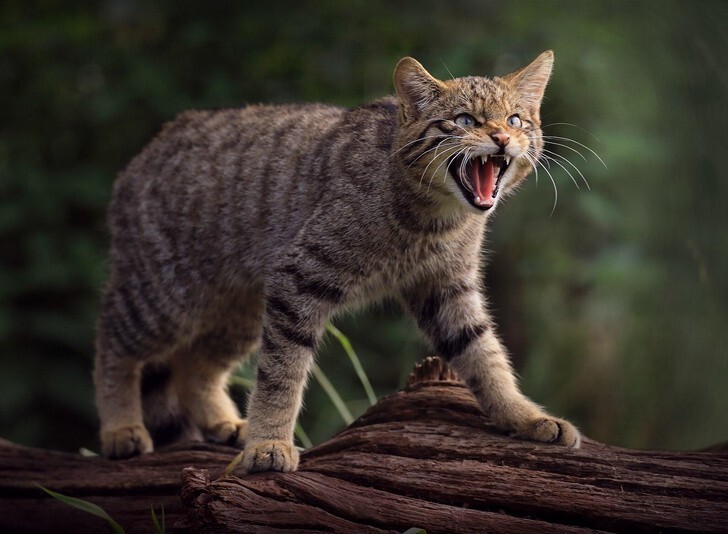
Forest cat (Felis silvestris)
Forest cats live in different natural conditions, successfully adapting to them. When encountered, a European cat can be mistaken for a runaway domestic cat, but the wild relatives of our pets are still somewhat larger: males can reach 90 centimeters or more in length, and their weight averages 5-7 kilograms. European cats do not like people and try to avoid contact with them.












